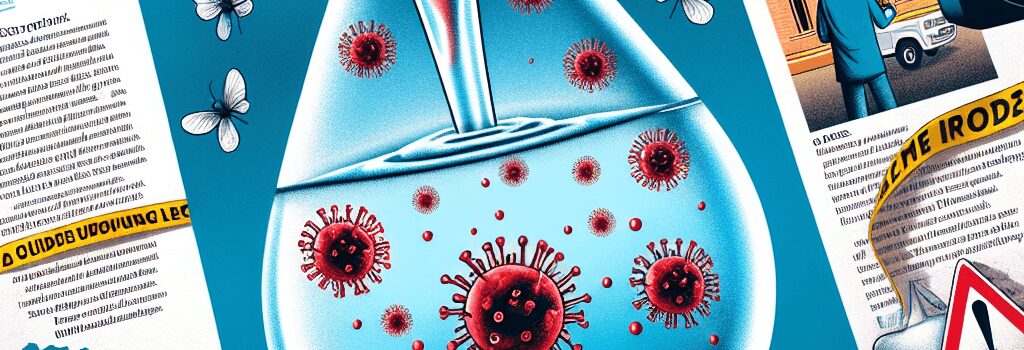Heavenly Hazard: Contaminated Holy Water Transports Drug-Resistant Cholera to Europe

What began as a spiritual quest for blessings and cleansing turned into an unexpected public health crisis. European travelers returning from Ethiopia with bottles of hallowed water inadvertently carried a potent strain of Vibrio cholerae, leading to a cluster of cholera cases across Germany and the UK. The situation highlights both the technical challenges of pathogen detection and the broader implications of international travel in regions experiencing outbreaks.
Incident Overview and Immediate Health Impact
The incident came to light following reports in Eurosurveillance of cholera infections among travelers who had consumed or applied holy water from a renowned Ethiopian well, known as Bermel Giorgis. In February, three cases in Germany and four cases in the UK were identified. Two of those required intensive care, but all patients eventually recovered. Detailed laboratory testing confirmed that the water was heavily contaminated with V. cholerae and maintained bacterial viability even after prolonged exposure to ambient temperatures during travel.
Technical Analysis: Contamination and Bacterial Load
One of the key technical details noted in the report was the highly virulent nature of the contaminating strain. Researchers estimated that the infectious dose of V. cholerae O1 lies between 105 and 108 colony-forming units (CFU). The exceptional bacterial load indicates severe contamination, suggesting that either the source had a continuous influx of bacteria or that environmental conditions favored the pathogen’s prolonged viability.
Antibiotic Resistance and Treatment Challenges
Laboratory analyses revealed that the cholera strain was not only aggressive in its infectivity but also exhibited significant resistance to multiple antibiotics. This strain showed resistance to a broad spectrum of drugs including fluroquinolones, trimethoprim, chloramphenicol, aminoglycosides, beta-lactams, macrolides, and sulphonamides. Furthermore, a plasmid carried within the bacterium conferred additional resistance against streptomycin, cephalosporins, and spectinomycin. Despite these challenges, the strain remained susceptible to tetracycline—a preferred antibiotic in cholera treatment regimes. However, emerging reports from other regions in Africa suggest a worrying trend toward developing even greater resistance, including to tetracycline.
Broader Public Health Implications and WASH Investments
The outbreak underscores the critical need for sustained investment in water, sanitation, and hygiene (WASH) programs, especially in regions plagued by ongoing conflicts and infrastructural challenges. The European Center for Disease Prevention and Control (ECDC) has raised concerns that, as long as contamination at the holy well persists, additional cases may occur. This incident is a stark reminder of how intertwined spiritual practices and public health can become when environmental and infrastructural issues are not addressed.
Deeper Analysis: Environmental and Technical Monitoring
Advances in sensor technologies and real-time water quality monitoring are being explored as methods to prevent similar outbreaks. Experts in environmental engineering are calling for the installation of automated remote sensors at critical water sources in outbreak-prone areas. Such technologies can provide early-warning signals by measuring key indicators such as turbidity, bacterial counts, and temperature fluctuations, thereby offering an additional layer of protection against waterborne diseases.
Deeper Analysis: Impact of Armed Conflict on Public Health Interventions
The contamination at Bermel Giorgis has been further exacerbated by regional instability. Ongoing armed conflicts complicate public health interventions by restricting access and disrupting routine monitoring. This creates a feedback loop in which both local populations and visiting pilgrims are at increased risk. Experts emphasize that robust international cooperation and humanitarian aid are essential to rebuild and maintain critical water infrastructure, along with improved surveillance systems.
Deeper Analysis: Global Travel and Infectious Disease Spread
The transmission of cholera through holy water also shines a light on the risks posed by global travel. In a world where even bacteria can hitch a ride across continents, clinicians and travelers alike are advised to exercise caution. Experts suggest that travelers, especially those visiting regions with known outbreaks, should adhere strictly to international health advisories and consider specialized pre-travel consultations. Enhanced screening and post-travel surveillance measures could prevent similar clusters of disease on a global scale.
Conclusion and Expert Recommendations
Diving deep into this incident reveals multiple layers of complexity—from the technical aspects of bacterial growth and antibiotic resistance to the geopolitical challenges that hinder effective public health measures. Experts advise that both travelers and clinicians should be aware of these risks. Travelers are urged to avoid ingesting or using potentially contaminated substances like holy water, especially when sourced from areas experiencing outbreaks. Clinicians should maintain a high index of suspicion for cholera, particularly in patients with recent travel histories to affected regions.
As global travel resumes normal pace post-pandemic and public health systems reassess strategies for outbreak intervention, the case emphasizes the need for cross-border cooperation in both surveillance and preventive measures. The incident is not merely a localized health concern but a reminder of the intricate links between cultural practices, environmental health, and technical challenges in disease control.